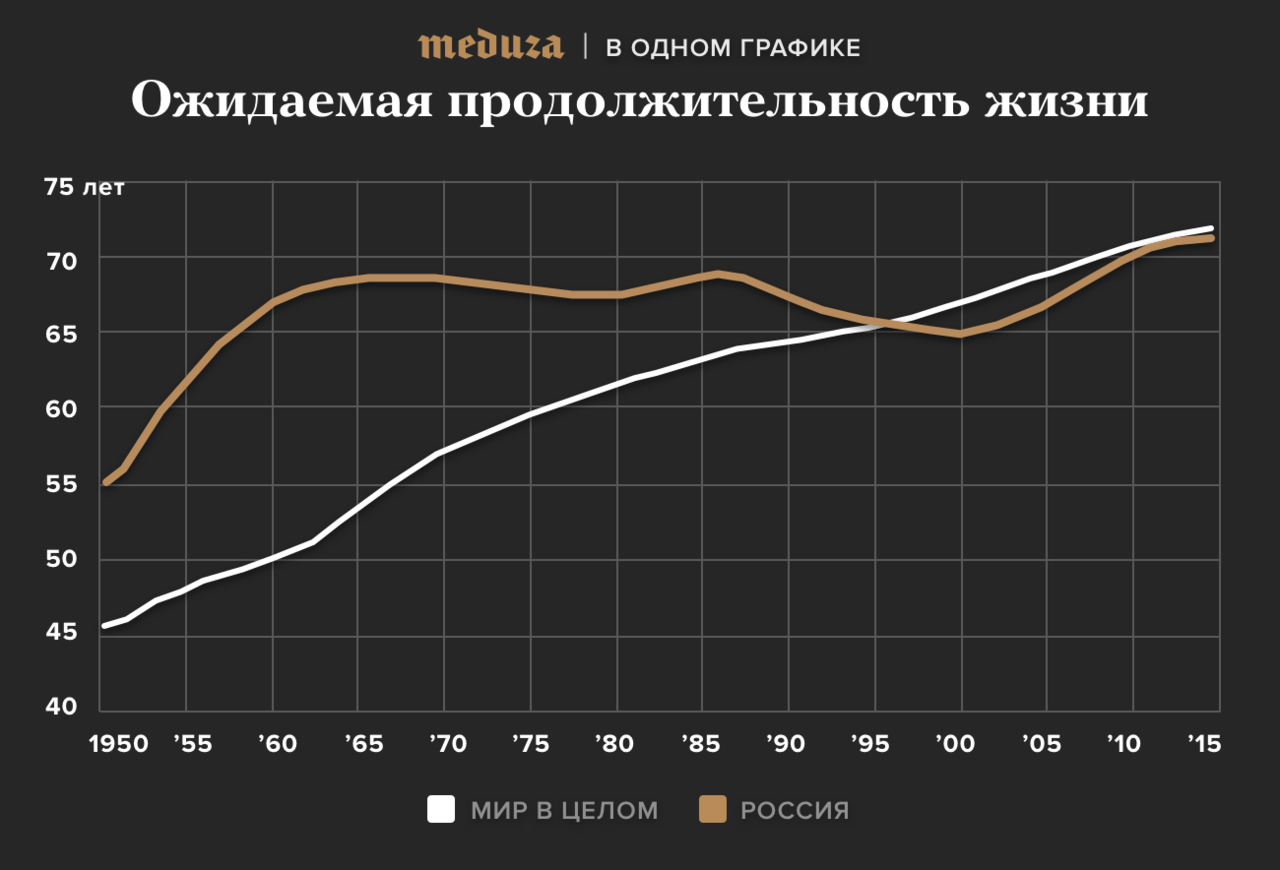On June 7, there was
news in the media that the Government would determine the parameters of pension reform next week. The basis for taking the option of increasing the retirement age to 65 years for men and 63 for women.

Let me remind you that now the retirement age for women is 55 years, for men it is 60. Thus, the main option is retirement for men 5 years later, and for women by 8. IT specialists, like all employees, according to the legislation of the Russian Federation, form their future pensions. With employee benefits, employers are required to deduct insurance premiums, including for pension insurance. In accordance with Articles 425-426 of the Tax Code of the Russian Federation, until 2020, the total rate for insurance contributions is 30%, of which 22% is for pension insurance.
According to the data
of the “My Circle” salary service, the median salary of an IT specialist is 90,000 rubles. Let's try to figure out how our pension will be affected by possible changes in the pension system.
On September 11, the Russian Ministry of Health
reported that the Russian life expectancy indicator broke the historical record and reached 72.5 years. By modern standards, the expected birth at 72.5 years - rather, it corresponds to the world average. After clarification, the indicator was 72.1 years (66.80 for men and 77.16 for women).

As a rule, by “life expectancy” (LE) is understood life expectancy at birth, that is, at the age of 0 years. This is the number of years that one person will live on average from a given generation of births, provided that throughout this generation the death rate in each age group will remain unchanged at the level of the calculated period. In short, mortality rates are taken for one year (according to materials of the Civil Registry Office for one year, for example 2017) for all ages of the conditional generation, and this data is distributed to the distant future.
What the Ministry of Health reported about is life expectancy for people born in 2017. The average (expected) life expectancy is not the average age of the deceased during the calendar year. Statistics from the registry offices really underlies the indicator LEs, but is used to calculate the probabilities of death during the year at each age. The LE indicator itself is obtained by constructing full mortality tables. This indicator can coincide with the average age of the deceased only by chance.
In
Cloud4Y , we wondered how many years a man would receive benefits when he retired at 60 and 65, and how a later exit would affect the usefulness of this system for a particular person.
Life expectancy at birth cannot help with this calculation. We needed to find out how many years on average a man lives, who has reached the age of 60 years. The “
Mortality table of the population of Russia for the calendar year 2014 ” helped us with this. Source:
www.mortality.org - they refer to Rosstat's unpublished, but available for researchers, data.

To begin with, in 2014, only about 67% of men reached 60 years of age and older, while the age of 65 years was 57%. This is a partial answer to the question of the possibility of surviving a pension. Yes, it is quite possible. In addition, we note that before the insured event of pension insurance, with such an increase in age, it survives by 10% less than men. Further, all calculations are made for survivors.
How many years on average receive a pension who have lived to 60 and 65 years?
Drawing attention to the column “Expected life expectancy for those who lived before age x”, we see that in 60 years, the “average man” according to 2014 will have to live 15.84 years and get 190 pensions, and at 65 years - 13.16 years and 158 pensions.
Yes, one would have thought that 5 years of raising the retirement age would reduce the length of the period of "retirement" by 5 years, but this is not so. The probability of death does not increase linearly, which means that in 5 years from 60 to 65, significantly fewer men die than from 65 to 70 years and so on.
Raising the retirement age by 5 years is a reduction in the period of receiving a pension by an average of 2.68 years, or almost 17%.For women with retirement at 55 years old, life expectancy was +25.53 years in 2014, and 19 years at the retirement age of 63 years.
Thus, raising the retirement age by 8 years for women means reducing the period of receiving a pension by an average of 6.48 years or more than 25%!So, back to the average IT-specialist who receives 90 thousand rubles and whose employer transfers 22% to the FIU. In 2018, the limits for assessing contributions to the Pension Fund of Russia were changed to 1,021,000 rubles. (in case of excess, contributions are paid at a reduced rate of 10%). There are also reduced rates for certain types of organizations.
Annual deductions to the Pension Fund for such an employee will amount to 230.5 thousand rubles. Since the total annual income is close to the accrual limit at a rate of 22%, and we do not know the dates on which the state will raise the limit, we will assume that the wage growth will exactly correspond to the inflation rate.
For calculation, this means that for the rest of his working life, the employee will receive 90 thousand rubles with zero inflation.Also suppose that at the moment an employee is 30 years old and before retirement he will have another 35 years of work experience.
Consider the option when the employee begins to set aside money for old age on their own at a rate equal to the pension contributions. The employee places the funds on a bank deposit with a monthly interest capitalization. Due to zero inflation in the economy, the rate on bank deposits is only 1% per year.
- On such a deposit for 35 years, the employee will save up 9.6 million rubles. On average, he would have to receive 158 pensions, each of which would be equal to 61,000 rubles in today's prices.
- For an average woman who retired at 63 years old with an expected life of another 19 years, an independent pension would be 42,000 rubles a month.
The example with a salary of 90 thousand rubles per month in 2017 prices is indicative because of the receipt of total annual income close to the limit of accrual at a rate of 22%. If your salary is lower than 90,000 N times, the expected alternative self-accumulated pension will also differ N times.
By making deductions for a “private” pension, as in our example, an employee can achieve a wage replacement rate of 67.8% for the average man and 46.7% for the woman. In 2016, this ratio was 33.7%, with the average salary in Russia, according to Rosstat, at 36,746 rubles and the average pension at 12,391 rubles.
Thus, we are talking about a twofold difference in the replacement rate for men between the “private” and state pensions.With the "old", the current retirement system in 60 years, the male employee will receive a pension on average 15.84 years, which means 190 times. It should also be noted that the employer will make deductions to the Pension Fund for 5 years less, which means the amount of accumulated funds and interest will be reduced.
In our example, it will be 8.47 million rubles instead of 9.6 million and 44,600 rubles instead of 61,600 rubles. The replacement rate would be 49.6%.The calculation for women is 25.53 years of retirement or 306 payments of 27,700 rubles each with a replacement rate of 31%.
This means that if, before a possible increase in the retirement age, for women with wages below average in Russia, the state pension was beneficial, providing a salary replacement of 33.7%, then after raising the retirement age by 8 years, such an opportunity to “get more private pension” greatly reduced.
Why not move to a private model of accumulation?
The existing model of the pension system is based on the mechanism of intergenerational transfer. In such a system, pension contributions of people working now go to paying pensions to previous generations. Deductions also go to the funded personified part of the pension, but in recent years it has been frozen and
may be canceled by replacing it with a voluntary funded pension.
The size of the intergenerational transfer does not allow canceling the existing mechanism that does not allow accumulating personal retirement and%. To cover retirement obligations to current retirees would require a huge amount of financial resources.
The younger generation, or rather its “behavioral irrationality”, may adversely affect the existing model of the pension system. The experts of the Central Bank came to this conclusion when drawing up the report
“The main directions of the financial market for the period 2019-2021” .
“Despite the comparative activity of Russian youth in the formation of savings, its majority is inclined to invest free money in obtaining high-quality impressions, which in their motivation are not always future-oriented.
In addition, the desire for control over their own destiny reduces the tolerance to participate in “joint” schemes. In the medium term, this may undermine the stability of the existing model of the pension system based on the intergenerational transfer mechanism, ”the report says.
People of the next generation, Z (born no earlier than the mid-1990s), have a short planning horizon, and most do not set ambitious goals for themselves in order not to be disappointed.
The philosophy of a society of universal consumption - “live one hundred percent here and now” - leads to an increase in the level of debt load, improving the short-term prospects for the production of goods and services, but creates potential risks for longer-term prospects.
This really poses a threat to the existing pension system in Russia, based on the continuity of generations, not only personal, within the same family, but generally through the system of redistribution of resources through the national Pension Fund.
Conclusion
Readers wishing to confidently meet old age, we recommend to look into the hub
"Health Geek" in order to reach the age of receiving the state pension, as well as to save funds for a "private" pension, which, as calculations have shown, is more effective.